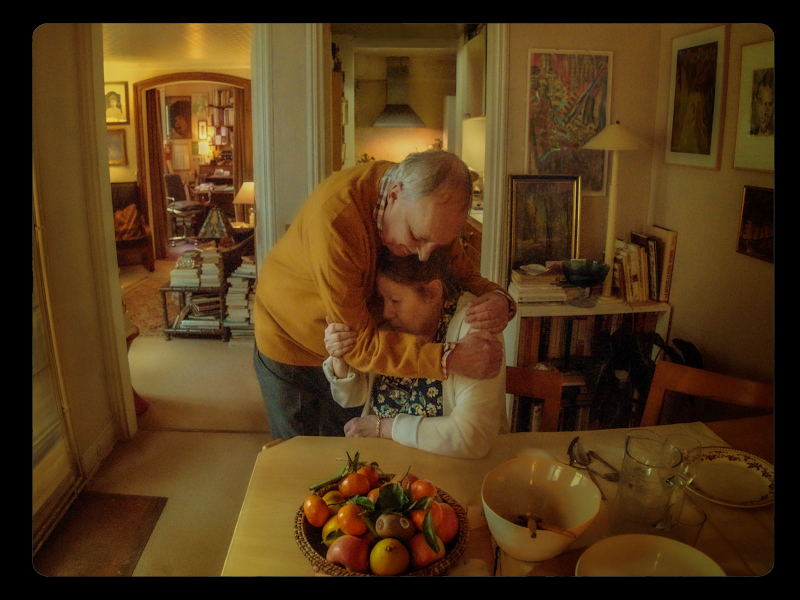Director – Gaspar Noé – 2021 – France – Cert. 15 – 142m
*****
An elderly man struggles to care for his ailing wife who has dementia – out in cinemas on Friday, May 13th
Discounting the lengthy titles detailing among other things the various film clips and images used, this throws us a series of images in a pillarboxed 4:3 format with curved corners at the edges (suggesting a projected slide show or physical, analogue photographs mounted in an album) then the young Françoise Hardy singing “Mon Amie La Rose” loads irony into the proceedings: the rose is fresh and speaks to us of love, the singer young and yet to be ravaged by the passage of time. (It’s not mentioned here, but last year, Hardy announced she could no longer sing as a result of cancer treatments, which lends the video a certain poignancy today – even more so in the context of this film.)
Then the man we’ll call the father (Dario Argento, director of such Italian gialli as Suspiria, 1977; Tenebrae, 1982) waves through windows across a courtyard at the woman we’ll call the mother (Françoise Lebrun from The Mother And The Whore, Jean Eustache, 1973) and they meet up for a glass of wine on their balcony. (Neither character is named during the film.) Life seems good.
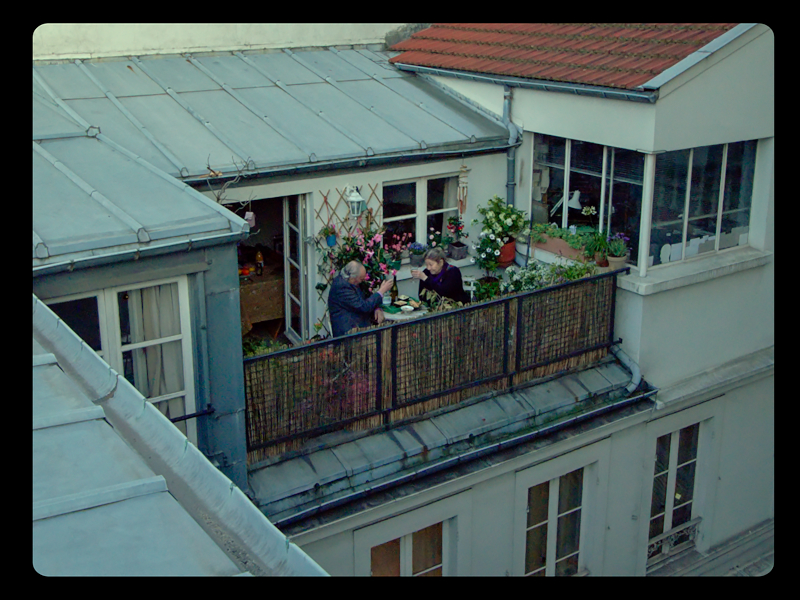
Noé settles on a moving image of the elderly couple asleep in bed. Slowly the image widens to fill the letterboxed frame, and somewhere along the line a central vertical line divides the letterboxed image into two left- and right-hand side square images, again with curved corners at the edges. Thus is introduced the split screen device that will remain in use throughout the film. Broadly speaking, one side represents the father and the mother, but the two swap around from time to time and sometimes other characters appear in shots on one or other side, such as the couple’s grown up son Stéphane (Alex Lutz) and / or their grandson by him Kiki (Kylian Dheret).
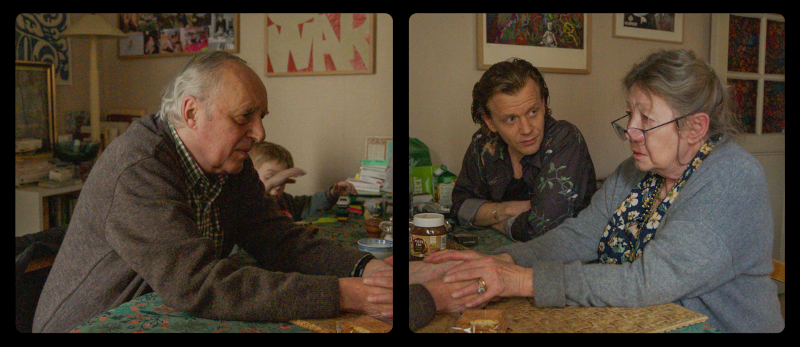
There’s a long history of split screen in the cinema, a favourite device of director Brian De Palma (Carrie, 1976 and much else), but only rarely has it been used throughout the entire length of a feature film: Timecode (Mike Figgis, 2000) ran four sets of moving images throughout. Noé himself played with it in his 51m short Lux Aeterna (2019) and in Vortex uses it quite specifically to show us a couple (and their descendants) and his use of the device as such proves highly effective. The father and the mother lying in bed at the start changes into her getting up, pottering around their flat then wandering out to the shops while he sleeps in, wakes up, realises she’s gone out and goes out himself to find her. She has dementia and sometimes doesn’t really know what she’s doing. At other times, she’s more lucid and feels a terrible burden on her husband and son.
The split screen gives a strong sense of the pair’s identity as a couple, rather than two individuals. For instance, on occasion as they move around and pass each other in the flat, Noé sometimes uses the moment to switch the two of them over from left to right and vice versa, reinforcing their joint rather than separate identity. Similarly, when he has the son visit with the grandson, the effect shows us not four individuals but four members of an extended family. The father’s side also shows us a phone conversation and brief, a real life meeting of the previous lover Claire (Corinne Bruand) the father has never got over which takes place at an editorial meeting.
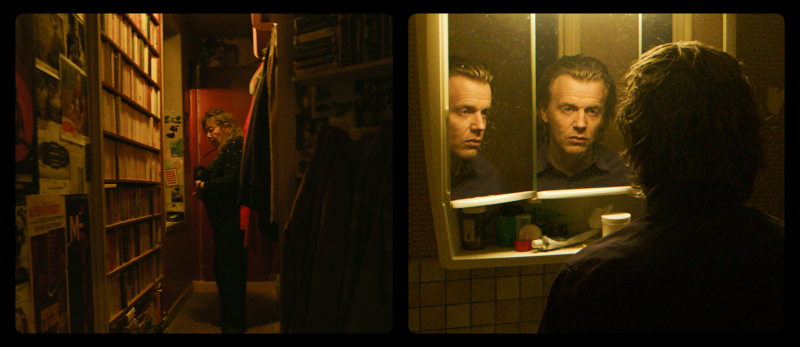
The father is writing a book on cinema and symbolism while the mother was a doctor. The flat is filled with books – presumably a combination of his lifetime of research and her medical books (though there’s never any suggestion of the latter). She goes around compulsively tidying up after him, as she sees it, at one point flushing the written notes of his current book project down the lavatory while he’s taking a shower. Their son warns the father that she is also mixing various medicines in an attempt to provide him with the right (as she sees it) medication, even going to the pharmacy to acquire the prescriptions she’s written in her own hand. The father isn’t worried because the pharmacy staff know her and won’t comply with her wishes.
Perhaps he’s living in cloud-cuckoo-land as elsewhere we see her taking Euro notes from his wallet. On another occasion, he finds she’s left the kitchen stove gas on causing him to rush in there, turn it off then open all the windows to admit fresh air; she, all sweetness and light, seems to have no idea of anything being wrong.
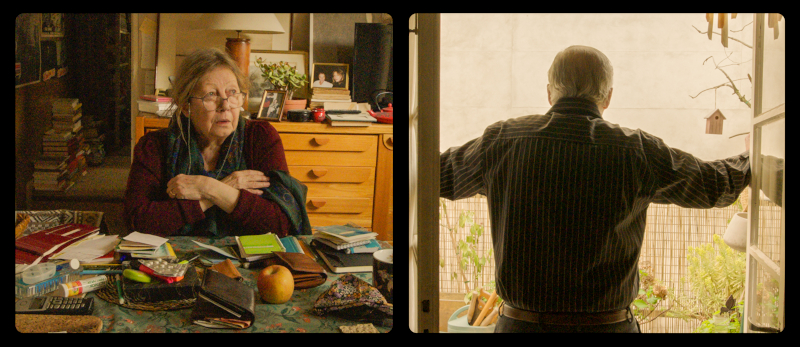
If the artifice of split screen is well to the fore, Noé’s highly appropriate use of the device to express the couple means it helps rather than hinders the story he wants to tell. As important as the split screen is the staging of what happens, the choreography relating the two screen images and the performances of the actors, particularly (because they’re given more screen time than anyone else) the two leads. Both are extraordinary, and you often get caught up watching one rather than the other, although sometimes you’re watching both.
Towards the end, one of them has a heart attack in the middle of the night (this devastating sequence runs about four minutes) which puts them in the hospital. Following death, the surviving partner is represented on one side of the screen with a black space on the other, which speaks eloquently of what happens when one person in a couple dies and the other is left behind. Funerals and bereavement are also tackled towards the end. Have granny and grandpa gone to a new home?” asks the grandson innocently as the couple’s ashes are put into a wall in a columbarium. “No,” says the son, “houses are for the living.” Clearly the son has no belief in an afterlife.
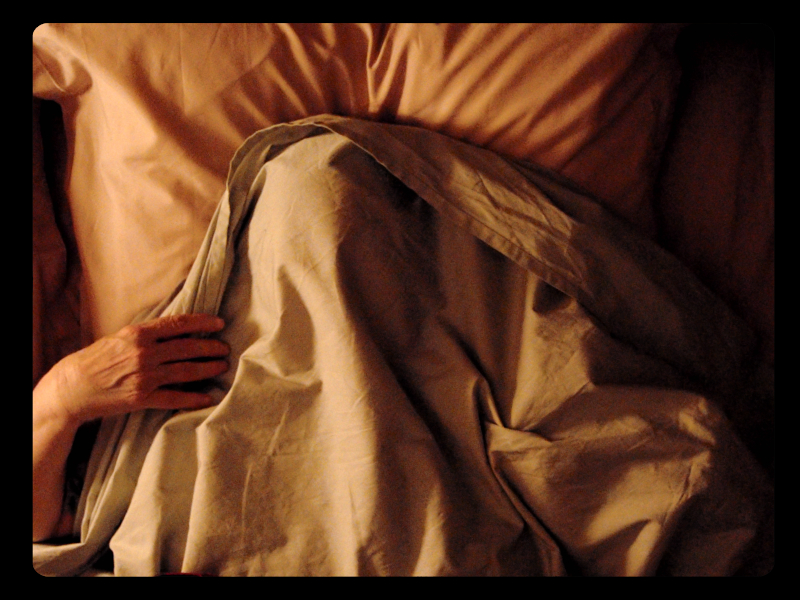
Noé’s cinema is noted for its excess, often sexual and / or drugs related. There’s no explicit sex here, although the son is a drug user which allows for more than a smattering of drugs-related material (he works in a night kiosk allowing users access to sterile rather than infected needles and similar), This film is excessive in a different way: it breaks taboos around old age and shows us the difficulties that can sometimes be faced by the elderly in their day-to-day living. That makes it a tough watch when such matters rarely appear in the cinema, but a worthwhile one nevertheless.
Vortex is out in cinemas in the UK on Friday, May 13th.
Trailer:
